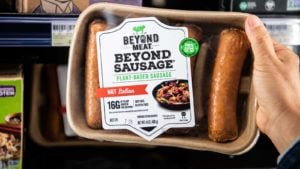Beyond Meat (NASDAQ:BYND) reported its Q3 earnings on November 9 and they showed a significant slowing in revenue and profits. So why is Beyond Meat stock still trading as if the company’s growth is accelerating? This is not likely to last much further.
Beyond Meat stock trades at very high multiples of revenue and earnings. This is not going to last for a company that has lost its growth traits.
For example, on Nov. 9 Beyond Meat reported that net revenues grew just 2.7% year-over-year (YoY) to $94.4 million. But Q2 net revenues were $113.3 million and Q1 was $97.1 million.
So Q3 revenue fell by $18.9 million quarter-over-quarter (QoQ), or 16.7%. And from Q1 it is down 2.7%.
Moreover, this is not a company that is in growth mode. The Covid-19 pandemic has taken away the taste for meatless meat, even during Q3 when economic activity increased. Earnings growth has stalled as well. Net loss increased from $10.2 million in Q2, to $19.3 million in Q3, an increase of 47% QoQ in losses.
Even Adjusted EBITDA deteriorated. In Q2 it made positive $11.7 million. But this fell to a loss of $4.3 million in Q3.
These numbers are nothing to write home about. So why is the stock so expensive?
Valuation Out of Control
Beyond Meat has a market capitalization of $7.8 billion as of Nov. 13. That is wholly-of-whack for a company with run-rate annual net revenues of $378 million (i.e., $94.4 million in Q3 times 4). It implies a multiple of revenue of over 20 times.
That is a multiple that is normally high even for price-to-earnings (P/E), much less the top-line revenue number. For example, by mathematical deduction, a 20 times P/E ratio would lead to a much lower P/S ratio, since revenue is always a higher absolute number than earnings.
However, analysts estimate that revenue in 2021 will turn around to major growth. That probably accounts for a good portion of the reason why Beyond Meat is still so highly valued.
For example, Yahoo! Finance reports that 22 analysts still have an average revenue estimate of $679 million for 2021. Seeking Alpha reports 19 analysts with an average estimate of $663 million. The average of these two, $671 million, is 59% over the $423 million average forecasts for 2020.
But it also lowers the P/S multiple to 11.7 times from 20 times. But the problem is it requires a leap of faith that people will start buying Beyond Meat products again. For some reason, analysts think that despite the gain in economic growth in Q3 and still lower sales, next year will bring a turnaround.
Or maybe these 2021 analyst estimates need to be updated now that the company has produced lousy Q3 results.
What Analysts Say About Beyond Meat Stock
On Friday, Nov. 13, Barron’s wrote that “Beyond Meat Stock Could Drop to $100 …”.They referred to a report by Barclays analyst Benjamin Theurer who kept his Underweight rating on the stock after earnings came out.
His thesis is that “the company faces tough comparisons and ongoing pressure on its restaurant business.”
He also thinks the company has lost market share to Kellogg (NYSE:K) and private company Impossible Foods.
Moreover, the Barclays analyst says that the company is continuing to pick up new restaurants and clients. This apparently includes McDonald’s (NYSE:MCD), with its new McPlant sandwich, although that has yet to be confirmed by McDonald’s.
So far this year Beyond Meat stock is still up 65% year-to-date, and up over 57% in the past year. So investors are not completely disappointed with the stock.
However, TipRanks.com reports that the average analyst target price is just $115.33, or 7.5% below today’s price of $124.74 (Nov. 13). Similarly, Marketbeat.com reports that the consensus target for 21 analysts is $108.86, or 12.7% below today’s price.
What To Do With Beyond Meat Stock
Given the low scenario and the recent downgrade by the Barclays analyst, I suspect that Beyond Meat stock is going to be in the doldrums for a while.
For example, it might be easier to wait until the stock potentially trades below $100, as the Barclays analyst predicts.
Another way to do that is to short puts at $100 per share. That way you get paid a little bit while you wait to buy the stock at $100, effectively lowering your cost. Depending on how far out you set the expiration period will determine how much you collect.
For example, the Dec. 18 puts will bring in an extra $1.35 per share, lowering your potential cost to $98.65 per share. If you are happy to buy the stock at $100, this is a cheap way to lower your cost and keep disciplined about buying around $100.
Therefore most investors might want to wait to find an opportune time to buy the stock lower, especially if growth begins a turnaround sometime next year.
On the date of publication, Mark R. Hake did not have (either directly or indirectly) any positions in any of the securities mentioned in this article.
Mark Hake runs the Total Yield Value Guide which you can review here.
